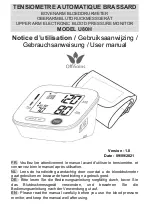
Operation Theory
Page 9
MD 1998LE (B1997PNST)
3
Operation Theory
This is an I2C-bus fully digital controlled multi-sync color monitor, compliant with VESA DDC1/2B and
DPMS standards. Besides, it also meets TCO95 and MPRII requirements. It provides user friendly OSM
(On-Screen display Menu) controls, and offers the following main features.
3-1 Main Features
1. Simplified chassis design with minimum components.
2. Fully digital controlled via 8-bit microcontroller NT6861AU.
3. Auto switching to off mode under “OUT OF RANGE” (Fh < 29KHz or Fh > 99KHz).
4. Reliable chassis design through various internal circuit protections.
5. Universal full range AC input and low power consumption.
6. Five-country OSM language available for easy user controls.
7. Adjustable OSM display time and position.
8. Twelve preset modes up to 1600 x 1200 75Hz (Fh =93.75KHz).
3-2 Microcontrol Section
1. The microcontroller provides I2C bus (pin 27 & 28) for geometric controls via I401 TDA4856 and video
controls via I501 M52743. The geometric controls include H-size, H-position, V-size, V-position, Pincushion,
Pin-balance, Trapezoid, Corner, Parallelogram, H-focus, V-focus, H-moire and V-moire. The video controls
cover Contrast, Brightness, R/G/B gain and cutoff control alignments. Through 8-bit PWM’s (pin 1, 2, 3,
32, 36, 40) it provides factory controls for G1, NS-trapezoid, H-linearity, ABL, user control for Rotation
and one F/V for H-frequency driver compensation . Two I/O’s (pin 27, 28) are provided for I2C bus used
for I502 MTV021N-21 on-screen display.
2. In addition, the microcontroller offers Auto Mode detection via Hsync (pin 41) and Vsync (pin 42) inputs.
According to Auto Mode detection, VESA DPMS power saving (pin 29, 30) will limit the output power
under 15W for Standby or Suspend mode, under 8W for OFF mode. VESA DPMS mode indication is
done via I/O pin 17 & 18 to drive LED display on the front cover. Normal mode displays green LED,
Standby or Suspend modes displays Yellow LED while OFF mode displays Amber LED.
3. Auto factory alignment (ATE) and VESA DDC2B communication are through DDC I2C bus (pin 27, 28),
I704 24LC211 is dedicated for DDC EDID E2PROM. In order to get optimal H-linearity performance for
the full range frequency (31KHz - 98KHz), 4-channel CS are used at pin 20, 21, 22, 23, 24. F1, F2, UP
and DOWN function keys’ scanning are through 2 ADCs on pin 14 & 15. Q701 and Q702 delay circuits
are used for power-on reset at pin 4. In order to avoid I2C interference during H-size, H-position, V-size,
V-position, Contrast and Brightness alignments, the HUNLK from I401 TDA4856 is applied from Q703
inverter to IRQ at pin 16.
4. There are 12 factory preset modes and 8 user modes available. Related information data of those modes
are stored at 2 EEPROM’s (I702, I703) 24LC04.
3-3 Deflection Section
1. I
2
C -- autosync deflection controller is TDA4856.
2. The TDA4856 is a high performance and efficient solution for autosync monitors. All functions are












































